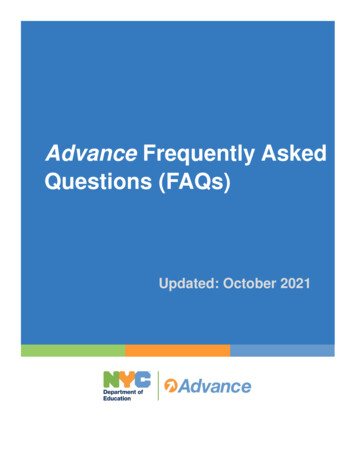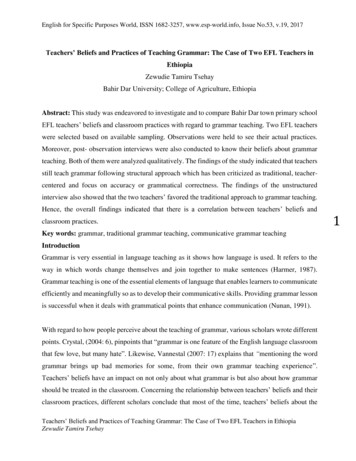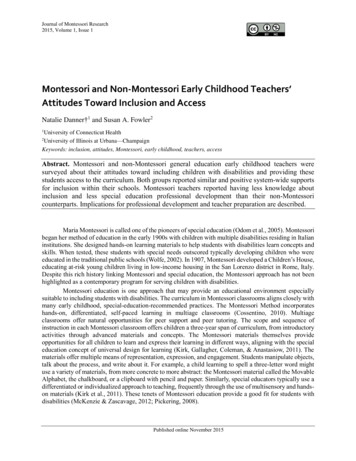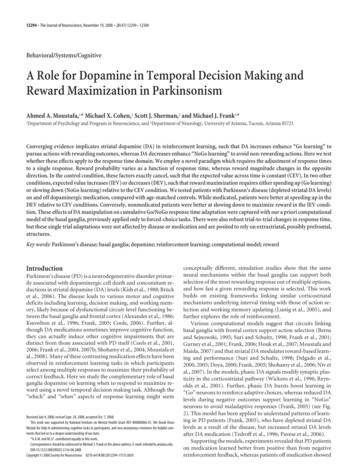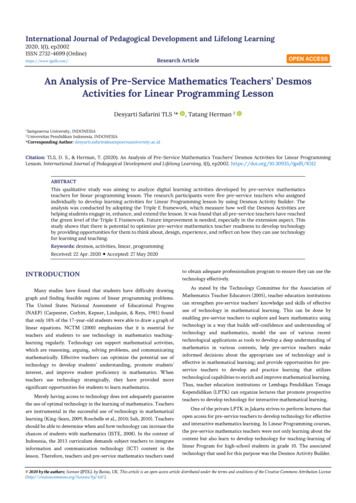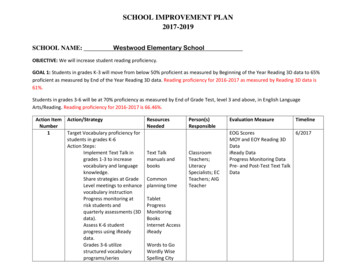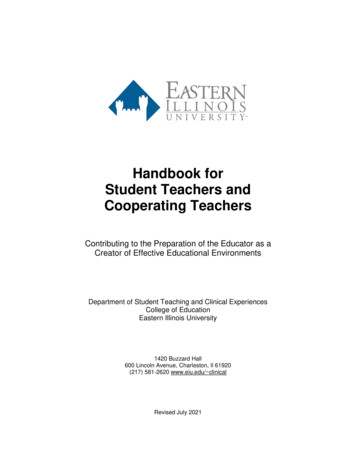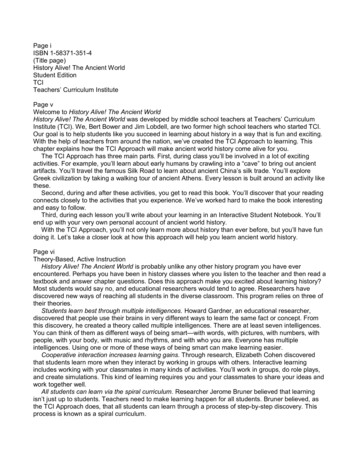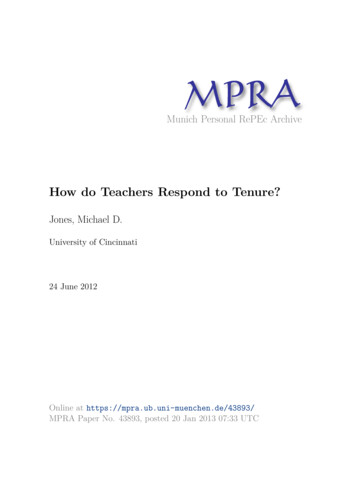
Transcription
Munich Personal RePEc ArchiveHow do Teachers Respond to Tenure?Jones, Michael D.University of Cincinnati24 June 2012Online at https://mpra.ub.uni-muenchen.de/43893/MPRA Paper No. 43893, posted 20 Jan 2013 07:33 UTC
1How do Teachers Respond to Tenure?Michael Jones*June 24, 2012ABSTRACTIn most states, K-12 teachers receive tenure after serving a probationary period of several years.Teachers with tenure, or a continuing contract, are guaranteed due process before they can bedismissed from their job. I use a restricted use version of the 2007 Schools and Staffing Survey(SASS) to estimate the effect of tenure on teacher behavior and time allocation at school andoutside of school. Estimates are obtained by exploiting the cross-state variation in theprobationary period length of novice teachers within a difference-in-difference framework. Ifind that in the year that teachers are evaluated for tenure, they spend significantly more of theirown money on classroom materials. Relative to the tenure evaluation year, once teachers receivetenure, they communicate less with students and parents outside of class and participate less inschool and district committees. In those districts where at least one probationary teacher is fired,I find that teachers reallocate their teaching time. Immediately after receiving tenure, they spendless time teaching math and more time teaching English.JEL Classifications: I21, I28, J22, M52Keywords: K-12 Education, Teacher Tenure* Author contact info:Michael Jones323 Lindner HallUniversity of Cincinnati, Department of EconomicsCincinnati, OH 45221michaeljones5660@gmail.com
21 IntroductionIn most public school districts, teacher tenure is a time-honored element of teacheremployment contracts. However, several states have recently introduced legislation to modify oreliminate teacher tenure. In 2011, the state of Florida passed a bill that any new teacher hiredwould receive a year-to-year contract, effectively eliminating tenure. In 2009, Ohio extended theprobationary period before a teacher is eligible for tenure from three years to seven years.Proponents of tenure argue that once teachers demonstrate competency during a probationarytime period, they should be protected from arbitrary dismissal. Opponents of tenure argue thatthe process of firing poor performing teachers is too time-consuming and expensive. Once ateacher receives tenure, school districts must follow a detailed and costly sequence of steps tofire a poor performing tenured teacher. As a consequence, few tenured teachers are fired forpoor performance in the United States. For example, from 2004 – 2008 Chicago Public Schoolsonly formally dismissed 9 tenured teachers, or 0.01 percent of its workforce. Prior to receivingtenure, school districts can fire, or fail to renew the contract, of a probationary teacher for almostany reason – with the exception of discriminatory or other illegal reasons. Because tenure statusincreases a teacher’s job security by reducing the likelihood of being fired, I investigate howteachers anticipate and respond to receiving tenure.In particular, I look at how teacher work hours and specific-subject teaching hours varyonce a teacher is granted tenure. I also look at the change in a teacher’s spending on classroommaterials and explore whether teachers change their time allocation in activities outside of theclassroom (e.g. club sponsorship, coaching, serving on school committees, etc.). Finally, Iconsider how teachers respond in districts where at least one probationary teacher’s contract wasnot renewed in the previous year. That is, I examine if a differential response exists in districts
3where tenure evaluation standards may be more stringent or more strongly enforced. To answerthese questions, I use data from the 2007-2008 restricted use version of the Schools and StaffingSurvey (SASS) and exploit the cross-state variation in the probationary period length of noviceteachers. The majority of states require that teachers serve for three years in a district beforetenure is granted. However, several states have shorter probationary periods of two years whileothers have longer periods of four or even five years. I use a difference-in-differencemethodology to investigate the changes in teacher behavior in the year immediately followingreceipt of tenure.Teacher tenure is a specific application of employment protection legislation (EPL)which consists of the laws and regulations that govern the hiring and firing of workers. Once ateacher is granted tenure, dismissal or firing costs increase considerably. There is a sizableeconomics literature on the effects of EPL on various outcomes of interest. Autor et al. (2007)found that the adoption of wrongful discharge protection laws in the United States altered firms’production choices, causing employers to retain unproductive workers and subsequently reducedtechnical efficiency. Blanchard and Portugal (2001) found that the strict employment protectionin Portugal profoundly affected the labor market relative to the United States and led to anincreased duration of unemployment. Heckman and Pagés (2000) showed that job securitylegislation in Latin America reduced employment and increased wage inequality across workers.Several other papers also found that EPL affects worker employment (Martins, 2009; Kugler andSaint-Paul, 2004; Miles, 2000; Lazear, 1990).There are also papers that investigate the impact of EPL on individual worker behavior.Ichino and Riphahn (2005) used data from a large Italian bank and found that employeeabsenteeism increased significantly once employees were no longer under a probationary period.
4Scoppa (2010) used the 1990 EPL reform act in Italy to investigate the effect on workerabsenteeism in that country. Using a difference-in-difference approach, the author exploited thefact that the law drastically increased the firing costs for small firms, and found that shirkingincreased once employees were granted firing protection. Despite this extensive literature, thereis little research that looks at EPL in the context of K-12 education. Jacob (2011) used the 2004new collective bargaining agreement in Chicago Public Schools (CPS) that gave principals theflexibility to dismiss probationary teachers for any reason, and found that annual teacherabsences were reduced by roughly 10 percent. Goldhaber and Hansen (2010) examine theimplications of using value-added models as a criterion for granting tenure to teachers. TheWidget Effect, published by The New Teacher Project, documents the relationship betweentenure and the number of teachers who are fired. While not specifically addressing teachertenure, Hansen (2009) used North Carolina administrative data and found that teacher absencesincreased dramatically in the year prior to teacher retirement or departure.I find that in the year that teachers are evaluated for tenure, they spend significantly moreof their own money on classroom materials. Relative to the tenure evaluation year, once teachersreceive tenure, they communicate less with students and parents outside of class and participateless in school and district committees. In those districts where at least one probationary teacheris fired, I find that teachers reallocate their teaching time. Immediately after receiving tenure,they spend less time teaching math and more time teaching English.2 State Variation in Teacher TenureThe history of teacher tenure in the United States began in 1909 when New Jersey wasthe first state to pass comprehensive tenure legislation for K-12 teachers. By the 1940s, seventy
5percent of teachers were covered by tenure protection; and today, nearly every state has passedlegislation granting some form of tenure. In order to receive tenure, new teachers in a schooldistrict must serve for a probationary period – typically for three years. In some states, tenurestatus is also called a continuing contract or permanent employment status. Regardless of itsname, tenure is a series of steps or due process that must be followed in order to dismiss atenured teacher. Under certain circumstances, it can take several years and hundreds ofthousands of dollars before a teacher can be fired. A spokeswoman for the New York CityDepartment of Education claimed that the cost to fire one incompetent teacher in its jurisdictionis 250,000.Proponents of tenure claim that it is necessary to protect teachers from unfair and/ordiscriminatory firing. Opponents argue that tenure protects ineffective or even incompetentteachers. According to data from the 2007-2008 SASS, only two percent of teachers in theUnited States were dismissed or failed to have their contract renewed. Table 1 shows the widevariation in dismissal rates across states. South Dakota removed almost 12 percent of itsteachers for poor performance while Arkansas removed only 0.2 percent.1 In some schooldistricts, that number is even lower. In The Widget Effect, the researchers found that from 2005– 2008, Denver Public Schools did not fire any school teachers for poor performance.1I tested whether the variation in firing percentages across states generated heterogeneity inteacher response. However, I could find no significant difference between states which fire arelatively higher percentage of teachers relative to those which fire a relatively lower percentageof teachers. This lack of heterogeneity could be due to the fact that outside of South Dakota andAlaska, every state fired less than four percent of teachers for poor performance. The samplesize in these two states is not large enough to make any definitive conclusions.
6Table 2 shows the probationary period that each teacher was required to serve beforereceiving tenure in 2008. While the state passes legislation to provide the scope or limitations ofthe tenure application process, the details are often left to individual school districts. Forexample, with over one million students, New York City is the largest, and arguably, the highestprofile school system in the United States. Over the last several years, considerable attention hasbeen devoted to the consequences of the tenure system in New York, and so I will provide a briefoverview of tenure in New York.New York state law requires that teachers be granted tenure after a majority vote of theboard of cooperative educational services upon the recommendation of the districtsuperintendent. The district superintendent must write a report to the board of cooperativeeducational services indicating that the teacher is “competent, efficient and satisfactory.” Thelaw further states that teachers shall not be removed except for any of the following causes, aftera hearing: “(a) Insubordination, immoral character or conduct unbecoming a teacher; (b)Inefficiency, incompetency, physical or mental disability or neglect of duty; or (c) Failure tomaintain certification as required by this chapter and by the regulations of the commissioner.”The state of New York requires that the district superintendent write a recommendationin order for a teacher to receive tenure. There is no rubric or requirement that teachers meetstudent achievement benchmarks or undergo a certain number of observations from a principalor third-party observer. In the 2010-2011 school year however, New York City introduced morestringent requirements in order for teachers to achieve tenure. Teachers are now rated under afour-point scale that must incorporate student test scores, classroom observations, and parentalfeedback (the previous rating system only measured two levels – unsatisfactory and satisfactory).
7The number of teachers who were denied tenure outright increased from 1 percent in 2006 to 3percent in 2011.Incorporating student performance in the tenure decision is rare at the state level. Duringthe 2007-2008 school year, only two states, Iowa and New Mexico, required that studentacademic performance be considered in awarding teacher tenure. Even in those states, studentperformance is not the predominant criterion for awarding tenure. Because states leave tenuredecisions to the discretion of the local school district, I also investigate to what extent studentperformance, specifically student growth, is discussed in school district contracts as arequirement for teacher tenure. Out of the 50 largest school districts in the United States, onlythree districts specifically require teachers to demonstrate student growth prior to being awardedtenure.From this evidence, it appears that few teachers on probation are denied tenure. In TheWidget Effect, the researchers find that in five of the six school districts they studied, less thanone percent of probationary teachers were denied tenure. Included among these five districtswas Chicago Public Schools which refused tenure to only 0.1 percent of probationary teachers.While this dismissal rate is a ten-fold increase from the 0.01 percent dismissal rate of tenuredteachers, it is still a low number.3 DataDetails on state tenure laws come from the 2007 National Council on Teacher Quality(NCTQ) State Teacher Policy Yearbook. In the yearbook, NCTQ publishes each state’sprobationary period before a teacher may be granted tenure, as well as a citation for the relevantstate law. In addition, prior to publication of the yearbook, the organization provides state
8officials with a draft copy of its findings in order to check the accuracy of its claims. Becausesome laws were written to permit school district administrators to have authority over teachertenure under special circumstances, at times, discretion must be used to code a state’sprobationary period into a numerical value. For example, the state of Maryland has aprobationary period of two years, but it may be extended to three years on an individual basis.NCTQ decided to code Maryland as having a two-year probationary period. In the four stateswhere NCTQ notes that there are potentially different interpretations, I follow NCTQ’s codingscheme.I match the 2007 NCTQ data to teacher response data from the restricted-use version ofthe 2007-2008 Schools and Staffing Survey (SASS), conducted by the National Center forEducation Statistics. Begun in 1987, the SASS is fielded every three to four years and surveys astratified random sample of public schools, private schools, and schools funded by the Bureau ofIndian Education (BIE). The SASS collects data on teacher, administrator, and schoolcharacteristics, as well as school programs and general conditions in schools. In addition torestricting the sample to public school teachers only, teachers who indicated that they receivedno salary or did not work full time were dropped from the analysis. Teachers from career orvocational schools, alternative schools, and special education schools were also removed fromthe sample. Because I am only interested in looking at teacher behavior around tenure, I removeteachers who have been teaching for 8 or more years. Table 3 provides summary statistics forthe 2007 SASS.Because the empirical results rely on a difference-in-difference methodology, I divide thedataset into states with two, three, and four year probationary periods. The combined samplecontains 27,260 observations. There are slight differences in teacher characteristics across the
9different probationary period states. The states with a two year probationary period haveteachers that are slightly older and less likely to be white. These same states have higherstudent-teacher ratios and a higher percentage of teachers covered under a collective bargainingagreement. Teachers in these states also spend larger amounts of their own money on classroommaterials. These differences are likely driven by the geographic nature of the two yearprobationary period states. These states include: California, Maine, Maryland, Nevada, SouthCarolina, Vermont, and Washington. Most of these states are located on the coast and havehigher costs of living. Because of these differences across states, I run a robustness check whichrestricts the data to particular probationary period states.The last column in Table 3 describes overall characteristics of the teaching labor force inthe 2007 SASS. Teaching is a female-dominated profession with more than three-quarters of allteachers being female. Approximately three-fifths of teachers work in a district with acollective-bargaining agreement. Teachers are asked to provide the total amount of hours spenton all teaching and school-related activities during a typical full week and the average for thisvariable is 53 hours per week. This self-reported number of work hours is higher than what isfound in other well-known datasets like the CPS; however, the SASS prompts the teacher toinclude hours spent during the school day, before and after school, and on the weekends. TheSASS also asks elementary teachers how many hours a week they spend teaching the followingfour subjects: English, math, social science, and science. Elementary teachers only spend about21 hours on average, or 40% of their work week actually teaching the material for these subjects.Teachers indicate that they spend about 425 of their own money on average onclassroom supplies. The fact that teachers spend their own money in the classroom is socommon that the IRS allows a tax deduction for these purchases called the Educator Expense
10Deduction. Teachers can deduct up to 250 of any unreimbursed expenses incurred for books,supplies, computer equipment, and other supplementary materials.In addition, I look at teacherparticipation in school extra-curricular activities as a measure of teacher devotion.Approximately fifteen percent of teachers coach a sport at the school they teach; and one-third ofteachers sponsor a school club. Over one-half of teachers indicate that they serve on a school ordistrict wide committee, while only ten percent serve as a curriculum specialist.In order for tenure to alter behavior, teachers must have flexibility to make changesaround school and extracurricular activities. In the SASS teachers are asked, “How many hoursare you required to work to receive base pay during a typical full week at this school?” Onaverage, school districts require teachers to work 38 hours a week. Since teachers indicate thatthey spend 53 hours on all teaching-related activities, there is still considerable flexibility forteachers to reduce participation rates in extracurricular activities. Likewise, if teachers arerequired to participate in professional development activities, teacher tenure could not affect anychanges in professional development participation rates. While states do require teachers toparticipate in some form of professional development to maintain their certification, there isoften a time window in which to complete these activities. For example, the state of Ohiorequires a teacher to complete 18 continuing education units over a 5 year time period in order tomaintain certification. Because a teacher has flexibility around scheduling these units, thepossibility of strategic behavior in response to teacher tenure exists.4 Empirical MethodologyTo estimate the effects of teacher tenure on effort, I use a difference-in-difference modelto exploit the cross-state variation in the time required for a teacher to earn tenure. I exclude
11Washington DC from the data since there is no required probationary period specified in theemployment contract. I also exclude Hawaii, Mississippi, and North Dakota, three states thathave a one year probationary period, because I cannot disentangle whether the changes in teacheroutcomes are from tenure or from the unique challenges of first year teaching. Within theremaining forty-seven states, I use the observations in the first year after a teacher receivestenure as the treatment group in the model. The control group consists of teachers who are in thesame year of teaching as the treatment group but have not yet received tenure because of thestate’s longer probationary period. I use this estimation method because simply comparing thedifferences in outcomes before and after tenure may be confounded by other factors that drivethese differences. For example, teachers with one more year of experience may not need asmuch time to teach the material effectively. There could also be changes in expectations aroundschool service activities for more experienced teachers. For these and other reasons, using stateswith a longer probationary period controls for the differences in teacher behavior that are notrelated to teacher tenure.Table 4 illustrates the identification strategy by looking at the change in classroomexpenditures across different years of teaching and different probationary period states. The firstand second columns of Table 4 report expenditures in the third and fourth year of teaching,respectively. The first row of Table 4 reports classroom expenditures for states with a 3 yearprobationary period. The second row of Table 4 reports classroom expenditures for states witheither a 4 or 5 year probationary period. In longer probationary period states, a teacher’spersonal spending on classroom materials does not noticeably change between the third andfourth year of teaching. However, in the states with a 3 year probationary period, there is adecline of over 80 in the fourth year of teaching (i.e. the first year that a teacher receives
12tenure). The basic difference-in-difference estimate shows a statistically significant decline of 110 in classroom expenditures.Figure 1 provides a visual description of the identification strategy by plotting the amountof unreimbursed money that teachers spend on classroom materials by the length of a state’sprobationary period. For the states with either a two or three year probationary period, Figure 1clearly shows a “spike” in classroom expenditures in the year that a teacher is being evaluatedfor tenure. Teachers in two year probationary period states spend more than 100 of their ownmoney in that year relative to the previous year or following year. This sharp increase inexpenditures in the year of tenure evaluation motivates the following empirical specification.For the empirical analysis, I estimate the following equation –Yidst β0 BeforeTenureEvalidstβ1 1YrTenureidstβ2 2PlusYrTenureidstβ3 Xidst β4 μs υt εidst(1)where Yidst is the outcome of interest for teacher i, in school district d, in state s, in teaching year,t. BeforeTenureEval is a dummy variable indicating if the teacher is in a year prior to the tenureevaluation year. 1YrTenure is a dummy variable indicating if a teacher is in the first year ofteaching with tenure, 2PlusYrsTenure is a dummy variable indicating if a teacher has two ormore years of teaching with tenure, Xidst is a vector of individual and district characteristics, μsare state effects, υt are teaching year effects, and εids is an idiosyncratic error term.2 Coefficientson the three tenure dummy variables are interpreted relative to the tenure evaluation year.2Individual and school district controls include: teacher age, teacher race, teacher sex, thestudent-teacher ratio, district expenditures per student, and whether or not the district has acollective bargaining agreement.
13Section 2 described how the details of teacher tenure can vary widely by state. Teachersmay respond differently during the tenure evaluation year in a state where the process of firing ateacher is more time consuming and costly in one state relative to another state. For thisempirical specification however, I do not distinguish between different aspects of tenure.Future research could look at how differences in due process affect teacher behavior. Therequirements of achieving tenure are relatively similar across the states. During the 2007-2008school year, only two states, Iowa and New Mexico, officially incorporated student test scoresinto the tenure decision. As a robustness check, I calculate the estimates after these two statesare dropped from the data.Another potential concern is how to address the tenure status of veteran teachers whotransfer school districts. There are a few examples where states have made it easier for veteranteachers to acquire tenure after transferring school districts. For example, in 2011 Illinois passedSB7 which allows previously tenured teachers who earned either a “Proficient” or “Excellent”rating to be eligible for tenure in 2 years if they earned an “Excellent” rating in each of the firsttwo years in the new district. A new teacher in Illinois would be on probation for four years,rather than two. With the limitations of the data, I cannot calculate whether or not this type ofcondition would be applicable for a teacher in the dataset. Therefore, I treat all teachers as underthe same tenure laws as specified in the NCTQ dataset. Including potentially tenured teachers inmy estimation strategy would bias my results towards zero.
145 Results5.1 Key FindingsThe difference-in-difference estimate of the effect of teacher tenure on classroomexpenditures is reported in column 1 of Table 5. Relative to the tenure evaluation year, teachersspend approximately 70 less on classroom materials in the years leading up to the evaluation.Likewise, they also spend approximately 70 less in the first year of receiving tenure. Thisamount reflects a 17 percent decline from the average of 425 spent on classroom materials. Thecoefficient of 71 on the Tenure Evaluation Year dummy in Column 2 of Table 5 clearly showsthe spike in expenditures in the tenure evaluation year. Column 3 of Table 5 shows the resultsusing a simplified difference-in-difference specification with only using dummy variables for thefirst year of tenure as well as for two or more years with tenure. Relative to teachers withouttenure, teachers in the first year of tenure spend 72 less on classroom expenditures. However,even though the coefficient on the “Two or More Years with Tenure” dummy is negative, it isstatistically insignificant, suggesting that the immediate drop in classroom expenditures may betemporary. Teachers may feel that they need to “take a break” after the tenure evaluation year,but behavior reverts back to trend after a one year pause. Column 4 of Table 5, which presentsthe baseline specification without any teacher or district controls, shows that the decline inclassroom expenditures is not driven by changes in teacher or district characteristics. Regardlessof whether teachers spend their own money as an investment in their students’ academicperformance or as a signal of commitment, teachers appear to perceive the return on their moneyto decline immediately after tenure.Table 6 shows the effect of teacher tenure on other measures of teacher effort. Whilethere is no decline in overall work hours, I find that immediately after receiving tenure, teachers
15are 1 percentage point less likely to pursue any form of professional development. Since 99percent of teachers are already participating in some form of professional development, themagnitude on this estimate is not particularly large. Teachers are also asked if they communicatewith students or parents outside of the classroom using any of the following: email, onlinebulletin board, course or teacher web page, blog, or instant messaging. In column 3 of Table 6, Ifind that teachers are significantly less likely to communicate outside of the classroom in the firstyear of receiving tenure compared to the tenure evaluation year. In column 4 of Table 6, I findthat tenured teachers feel they have more job security relative to the tenure evaluation year.Immediately after receiving tenure, teachers are ten percent less likely to agree or strongly agreewith the statement “I worry about the security of my job because of the performance of mystudents on state and/or local tests.” With two or more years of tenure, teachers are fifteenpercent less likely to agree with this statement relative to teachers in their tenure evaluation year.Table 7 shows the effect of tenure on extra-curricular activities outside of the classroom.Column 1 shows that teachers are seven percentage points less likely to serve on a school ordistrict-wide committee immediately after receiving tenure. Columns 2 and 3 of Table 7 show aparticipation rate spike in coaching a sport and serving as a curriculum specialist. Teachers whotemporarily coach a sport (or serve as an assistant coach) for one year may not be ideal forstudent development. In contrast to these declines, once teachers receive tenure, they are sixpercentage points more likely to sponsor a student organization, group, or club in the yearfollowing tenure. Teachers who would like to sponsor a club may feel that their time is betterspent on more visible and/or more rewarded activities during the tenure evaluation year. Tenuremay allow these teachers to pursue other student development activities. This reallocation of
16time between different extra-curricular activities may explain why tenure does not change theoverall level of teacher work hours.In Table 8, I restrict the dataset to only include districts where no tenured teacher wasfired in the previous year, but at least one teacher on probation failed to have their contractrenewed. This information comes from the SASS survey completed by district officials.District officials reported the number of probationary and tenured teachers that were fired in theprevious academic year. For those districts where at least one probationary teacher was fired,one might expect that teacher behavior around tenure would change the most (i.e. in thesedistricts, the tenure process appears to be more stringent). In these districts, I find a spike of 100 in personal money spent on the classroom during the tenure evaluation year – an evenhigher amount relative to the baseline estimate. I also find that there is a reallocation of howelementary teachers spend their tim
In most public school districts, teacher tenure is a time-honored element of teacher employment contracts. However, several states have recently introduced legislation to modify or eliminate teacher tenure. In 2011, the state of Florida passed a bill that any new teacher hired would receive a year-to-year contract, effectively eliminating tenure.

